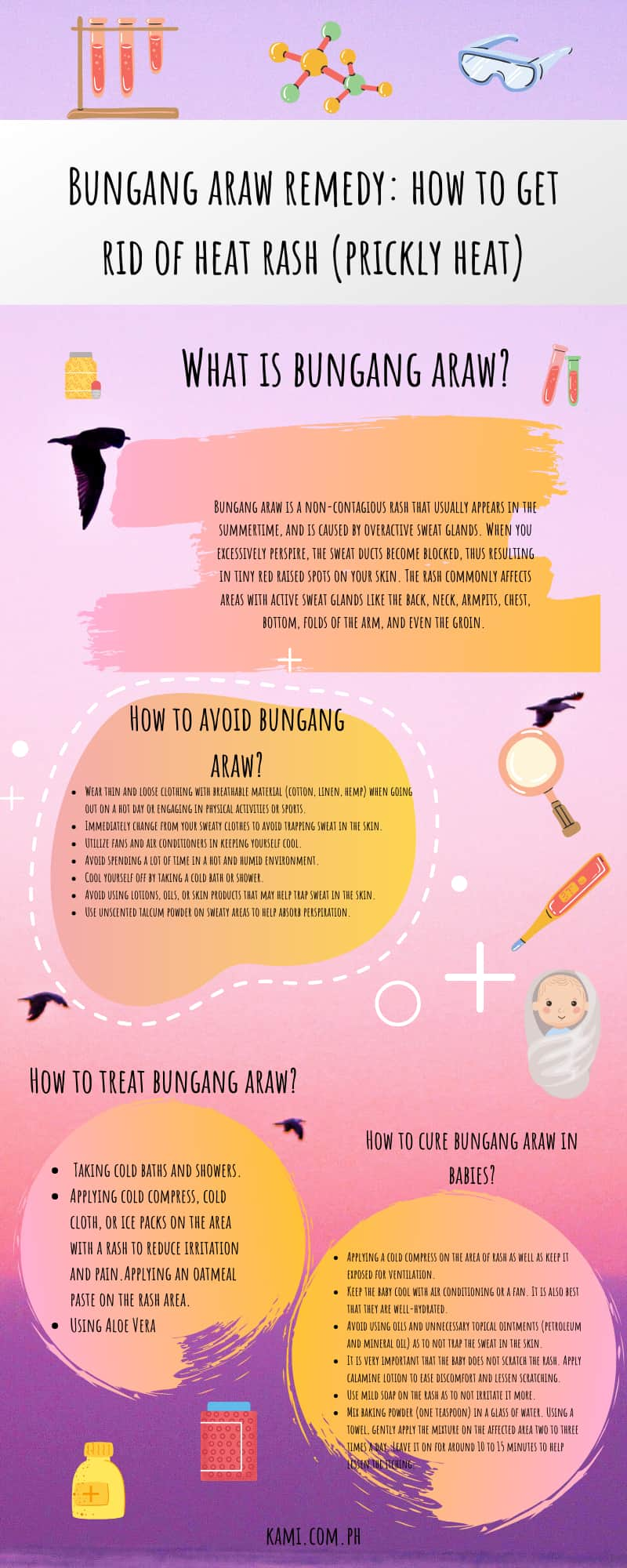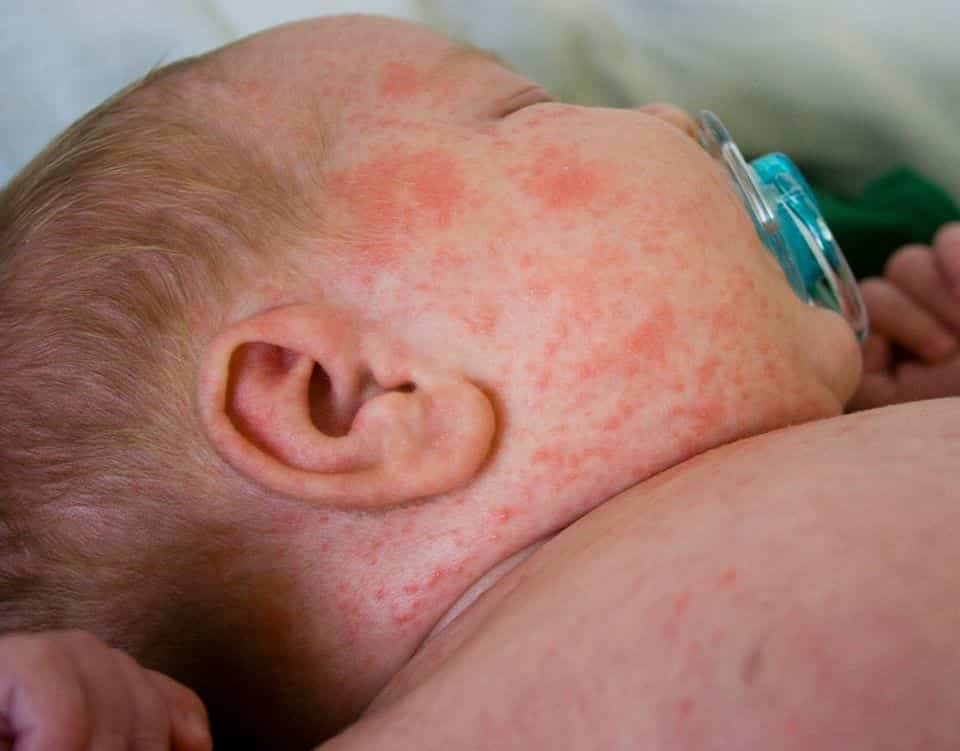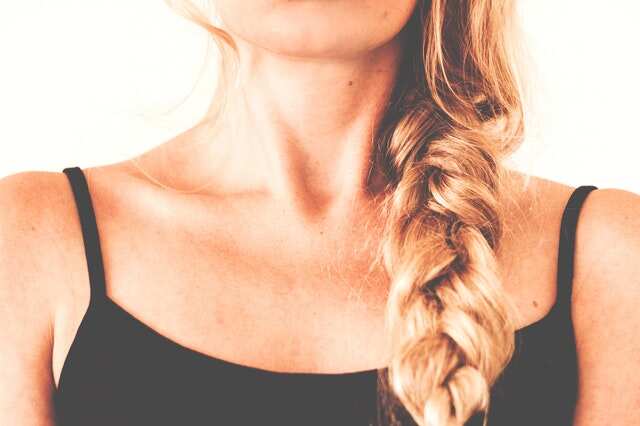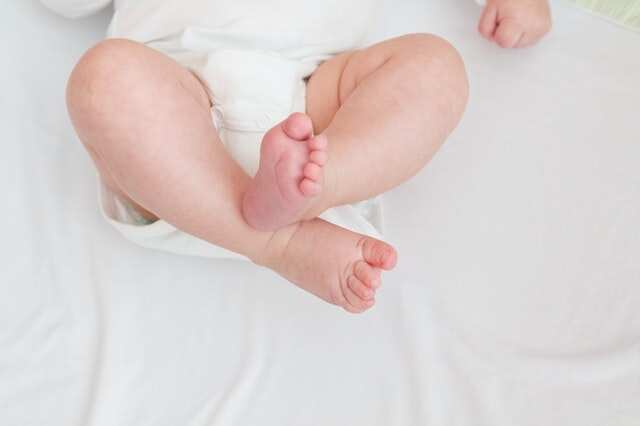Bungang araw remedy: how to get rid of heat rash (prickly heat)
The Philippines is known for its warm weather, which can be especially unbearable in the summer or dry season. Although it is great to enjoy some fun in the sun, sweating too much can lead to common summer ailments like bungang araw. What are the different kinds of bungang araw remedy?

Source: Original
Although this rash is a common and natural response of the body to over sweating, the rash's prickling sensation is a bothersome and uncomfortable feeling. To get rid of the itchy and annoying rash, proper bungang araw treatment can help.
What is bungang araw?
Bungang araw is a non-contagious rash that usually appears in the summertime, and is caused by overactive sweat glands. When you excessively perspire, the sweat ducts become blocked, thus resulting in tiny red raised spots on your skin. The rash commonly affects areas with active sweat glands like the back, neck, armpits, chest, bottom, folds of the arm, and even the groin.
What is bungang araw in english?
In English, bungang araw is known as "prickly heat", "prickly heat rash", or "heat rash." The name mirrors the itchy and prickly sensation of the rash, and the bungang araw causes which is hot weather and excessive sweating.
What does bungang araw look like?
The summer rash comes in many small raised spots on the skin. They are usually close together and cover the whole or a certain patch of skin in a specific area. Depending on which type it is, it may be reddish, flesh-colored, or even clear in appearance.

Source: Facebook
As the rash progresses, these bumps may swell, itch, become irritated or even turn into blisters.
Types:
This type of heat rash is 'clear' in appearance because it is a blockage of the sweat glands near the surface of the skin, or epidermis. These fluid-filled spots resemble 'beads of sweat' or appear 'droplike'. With light pressure, the rash can break or rupture.
This type is the most common and is the rash that has a prickly and itchy sensation. The sweat gets trapped in the dermis and epidermis, which results in reddish raised spots or papules. At times, the supposed papules manifest as pustules (filled with yellowish liquid) and it is then referred to as Milaria pustolosa.
- Miliaria Profunda
With Milaria Profunda, the sweat gets trapped in a deeper layer of the skin, the dermis. This is the least common type of heat rash and it appears in flesh-colored raised spots on the skin, with the papules resembling goosebumps. Additionally, it is the type recur and may even become chronic.
READ ALSO: Explainer: What is HIV, its symptoms, and how to prevent it?
How to avoid bungang araw?
Since the main cause of the prickly heat rash is hot weather and sweating, it best to keep yourself cool and dry. Do not hesitate to cool off using fans and airconditioners as well as changing out of sweaty clothes. Additionally, lessen the chances of having clogged pores by wearing breathable or loose clothing and avoiding slathering on lotions and oils.
Aside from finding a bungang araw solution, being precautious is also helpful. Here are some preventive methods for both adults and babies:
- Wear thin and loose clothing with breathable material (cotton, linen, hemp) when going out on a hot day or engaging in physical activities or sports.
- Immediately change from your sweaty clothes to avoid trapping sweat in the skin.
- Utilize fans and air conditioners in keeping yourself cool.
- Avoid spending a lot of time in a hot and humid environment.
- Cool yourself off by taking a cold bath or shower.
- Avoid using lotions, oils, or skin products that may help trap sweat in the skin.
- Use unscented talcum powder on sweaty areas to help absorb perspiration.
How to treat bungang araw?
There are many types of alternative medicine for bungang araw aside from over-the-counter antihistamines, and they are usually solutions you can find and do in the comfort of your home. The most effective methods of treatment are cold baths, cold compresses, oatmeal paste, and aloe vera.

Source: UGC
Here are some examples of home remedies for bungang araw:
- Taking cold baths and showers.
Cooling the skin down with a cold bath helps get rid of the heat rash as well as unclog the pores. Remember to use mild soap for bungang araw, to avoid further irritating the rash.
- Applying cold compress, cold cloth, or ice packs on the area with a rash to reduce irritation and pain.
- Applying an oatmeal paste on the rash area.
Oatmeal is known to relieve itching and inflammation which is why it is a popular natural remedy to skin conditions. Mix oatmeal with water to create a paste and apply on your rash. Another option would be to mix oatmeal in your lukewarm bath and soak for 20 minutes.
- Using Aloe Vera
Aside from its known purpose in nurturing hair, the Aloe Vera gel serves as an antimicrobial and anti-inflammatory aid. It's healing, soothing, and hydrating properties can help tend to heat rashes.
READ ALSO: 7 effective ways to finally get rid of unwanted body odor
How to cure bungang araw in babies?
Babies are more prone to heat rashes as their sweat glands are still developing and are not able to regulate their temperature well. When it comes to clothing, choose lighter and breathable materials. Airconditioning and fans are helpful in keeping babies cool, as well as having them drink plenty of water. If the baby feels discomfort because of the rash, applying calamine lotion can help in easing the prickly sensation.

Source: UGC
Bungang araw remedy for baby
Here are the simplest treatments for heat rash in babies:
- Applying a cold compress on the area of rash as well as keep it exposed for ventilation.
- Keep the baby cool with air conditioning or a fan. It is also best that they are well-hydrated.
- Avoid using oils and unnecessary topical ointments (petroleum and mineral oil) as to not trap the sweat in the skin.
- It is very important that the baby does not scratch the rash. Apply calamine lotion to ease discomfort and lessen scratching.
- Use mild soap on the rash as to not irritate it more.
- Mix baking powder (one teaspoon) in a glass of water. Using a towel, gently apply the mixture on the affected area two to three times a day. Leave it on for around 10 to 15 minutes to help lessen the itching.
If the rash continues to persist, it best to check with your pediatrician. Additionally, when babies or children scratch their rashes, it can lead to an infection. Be on the lookout for these symptoms that indicate an infected heat rash in babies:
- Chills or fevers
- Scabs or blisters
- Swollen, red, or intense pain around the affected area
- Pus on the area of rash
- Swollen or enlarged lymph nodes (groin, armpit, neck)
Although there is no definite bungang araw remedy that gets rid of the rash in an instant, it is important to note that staying cool, dry, and free from sweating too much is your ultimate defense against summertime skin ailments like the prickly heat rash.
Disclaimer: The tips, information, preventions, and solutions listed above are for general information purposes only. This article is not meant to become a substitute for professional medical advice, diagnosis, or treatment.
READ ALSO: Learn how to whiten underarms using these 8 amazing natural ways
Source: KAMI.com.gh







